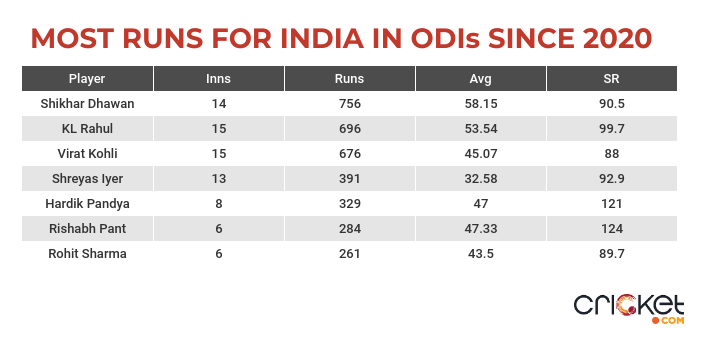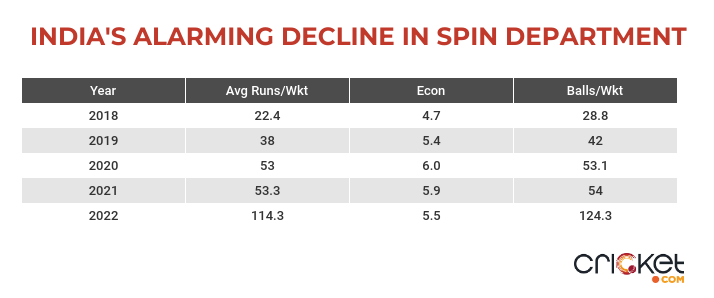 INDIA TAKEAWAYS
INDIA TAKEAWAYSShikhar Dhawan is going nowhere - and rightly so
Inevitably, even in ODI cricket, a conversation about Shikhar Dhawan tends to pop up everytime prior to a series, or immediately after a failure. But across the three games versus the Proteas, Dhawan showed why, if fully fit, he should pretty much be a lock at the top order.
Dhawan, in the series, scored 53 more runs than any other Indian batter, and batted with a control percentage higher than any other batsman across both sides (min 100 runs). In all games he looked assured at the crease, got the team off to a flyer and kept piling the pressure on the South African bowlers constantly.
Minus converting the fifties into match-winning hundreds, he did everything a team asks of an opener in ODI cricket.
But this shouldn’t be a surprise, for the 36-year-old has been doing the same for two years. Since 2020 Dhawan averages 58.15 in ODIs while striking at 90.53, and has notched up eight fifty-plus scores in 14 innings. He’s been both a model of consistency and positivity at the same time.

With the next 50-over World Cup a year away, it would be silly to think about moving on from Dhawan after investing in him so much. He might not have age on his side, but, performance wise, there is no reason to contemplate dropping Dhawan.
Finding match-winning spinners might be India’s biggest headache heading into the World Cup
A multitude of factors contributed to team India being whitewashed by the Proteas. A significant one was the toothlessness of their spinners.
Across the three games, Indian spinners took only three wickets at an average of 114.3, while striking once every 124 balls. In comparison, the South African spinners took thrice as many wickets at an average of 36 and a SR of 43.3. And yes, both Chahal and Ashwin were out-bowled by the part-time spin of Aiden Markram, both offensively and defensively.
Reading too much into these three games won’t be fair, but India’s spin-bowling stocks have been on a steady downward spiral for some time now.
 Chahal and Kuldeep are a shadow of their former selves, while the jury is still out on Ashwin. We’ve not talked too much about Jadeja the bowler but he is averaging 58.89 across his last 24 ODIs, primarily operating as an ultra-defensive option.
Chahal and Kuldeep are a shadow of their former selves, while the jury is still out on Ashwin. We’ve not talked too much about Jadeja the bowler but he is averaging 58.89 across his last 24 ODIs, primarily operating as an ultra-defensive option.
Given Jadeja is a sure-shot starter due to his all-round ability, the onus is now on the management to identify spinners who can win them games by running through opponents in the middle overs.
In addition to giving a few more games to Ashwin and Chahal (and maybe even potentially Kuldeep), it might be time to start integrating both Rahul Chahar and Ravi Bishnoi in the ODI set-up for the reasons mentioned above.
India need to find a way to somehow fit Suryakumar Yadav into the ODI side
So much has been spoken about how good Suryakumar Yadav is in T20 cricket, but the truth is, for some time now, he has been an outrageously good middle-order batsman in 50-over cricket in the domestic circuit as well. Since 2018, in List A cricket, he’s averaged 45.75 while striking at 122 and has done that while predominantly batting at 4 and 5.
And while he was benched for the first two ODIs, SKY, in Cape Town, in just 32 balls showed why team India could really do with his presence in the ODI side.

Not only does he possess outrageous dynamism, he is also experienced and is a player at the very top of his game. Crucially, he is someone who is genuinely adept at playing spin. He brings to the fore a package that is unique.
All his positive qualities were on display during his short stay in the third ODI, where he showcased his x-factor. Certainly, in the 32 balls he batted, he looked as good and assured as any Indian batter had looked all series.
That he deserves a good run in the side to prove himself goes without saying, but the headache for India is to find a way to accommodate him in the team. As things stand, the realistic way of having Suryakumar in the side seems to be dropping Shreyas Iyer altogether and slotting him in at No.5 or No.6, beside Pant and Rahul. Regardless of whether such a move is ‘fair’, it seems to be the best option available at team India’s disposal.
The jury is still out on Rahul Dravid the coach
To completely pin the blame on Rahul Dravid and his management would be silly, but it goes without saying that ‘The Wall’ made plenty of questionable calls across the three ODIs.
Why was Ruturaj Gaikwad not given a single game even in the dead rubber of a series with no consequence? There was the opportunity to rest one of Kohli or Dhawan in the final ODI. Gaikwad’s time will come, yes, but this was a golden opportunity to integrate him into the ODI set-up. He has now spent three months warming the bench despite top-scoring in both the IPL and Vijay Hazare Trophy.
Why was Venkatesh Iyer dropped after just two games? While it is true that Iyer did not fare well in the first and second ODI, there was every reason to give him the full series, particularly given he is being groomed as the alternative to Hardik Pandya. To drop any player after two games is harsh.
Why was Jasprit Bumrah not rested in the final ODI? Even if Bumrah is set to be rested for the West Indies series, there was simply no reason to play him at Newlands. He’d already endured a heavy workload across the first five games of the tour and there was nothing to gain in the final match. The decision was even more baffling considering there were both Saini and Siraj available at the management’s disposal for selection.
All this and we’ve not touched upon the decision to move Rahul back to the top of the order and demote Shreyas Iyer to No.5.
It’s been a harsh introduction to international cricket for Rahul Dravid the coach, but it’s up to him to win the trust of the fans through better results and decision-making in the ODIs against West Indies next month.
India cannot achieve balance without Jadeja or a bowling-fit Hardik Pandya
It should be the management’s job to ensure that both Jadeja and Pandya are wrapped in cotton wool prior to the 2023 World Cup so that at least one of them makes it to the competition fully fit. Because, as we witnessed in the South Africa series, the team simply cannot achieve balance without at least one of the two in the starting XI (a fully fit, bowling Pandya).
While the series was still alive, India tried compensating for the absence of Jadeja/Pandya by playing all-rounders at No.6 (V. Iyer) and No.7 (Shardul Thakur). But the ploy did not really balance the side - it instead weakened both bowling and batting.
While Iyer was green and showed that he might not be as strong a No.6 candidate as, say, Suryakumar Yadav, it was evident that Thakur is not consistent or potent enough to be a frontline bowler. And while he is, no doubt, a handy lower-order hitter, India do not have the luxury to carry a player who is neither a reliable batter nor a bowler.
A fit Jadeja will allow India to field six specialist batters and a finisher at No.7. The presence of both Pandya and Jadeja in the XI will give the team the option of fielding a third specialist spinner. The absence of both the players will weaken the team severely on at least one front, if not both.